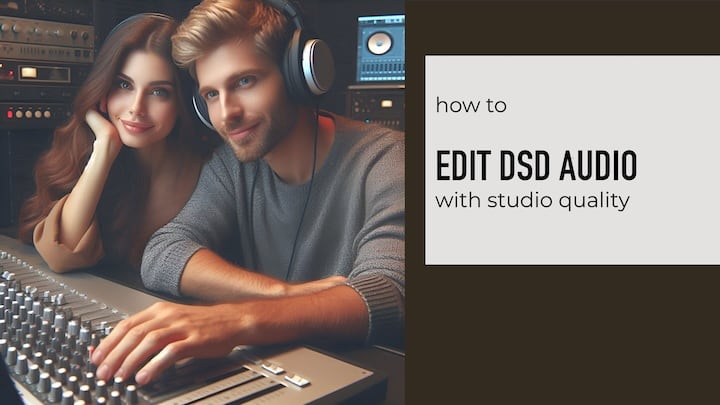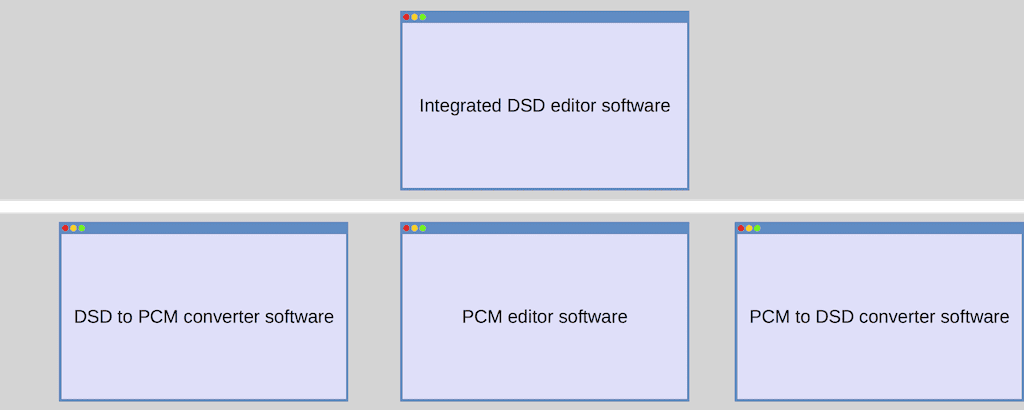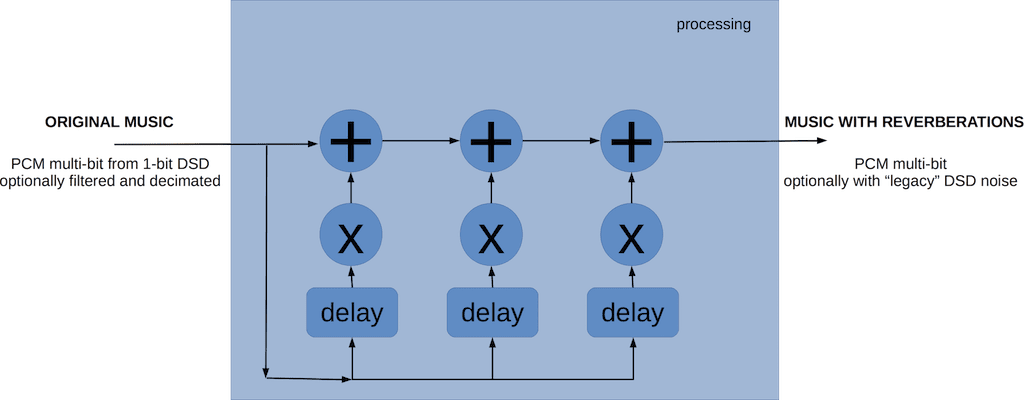
Audio Basis - articles about audio
DSD editing software is intended to content altering of DSF and DFF audio files: gain, cutting, merging, EQ, etc. DSD is a 1-bit signal based on sigma-delta modulation. Its editing is not obvious at first glance, unlike PCM. There are many disputes about "native" and "non-native" editing, "destructive" changing of original stuff. Read how to edit DSD and about the real damage of the editing.
If you buy "AuI ConverteR PROduce-RD" (2023/12.x version) from 24 August 2023 to 24 October 2023, you will get free update to version 2024 (13.x) after its release.
How to edit DSD
General issues
There are 2 ways:
- Using of integrated editor (1-bit/multi-bit converter [optionally: filtering and decimation] + processing + [optionally: upsampling] + re-modulator).
- Using conversion DSD to PCM > editing PCM in audio editor > conversion PCM back to DSD.
DSD editing ways
[How-to] Edit DSD with audio converter and editor
The author, know nothing about integrated DSD editor of a signal waveform.
However, you can edit the waveform of DSD audio file (.dsf or .dff or file, extracted from SACD ISO):
- Convert DSD file to WAV one with audio converter software that provides low distortions.
When converter is used, it is recommended to use WAV format with 32- or 64-bit integer or float bit depth to "transparent" (for music) processing. Float point format have better overload abilities comparing integer ones.
Recommended sampling rates are 352 kHz, 705 kHz, 1411 kHz. Read more details below.
- Use proper audio editor software for WAV files to edit waveform of audio signal and save back the WAV without altering source bit depth and sampling rate.
- Convert saved WAV to DSF or DFF file with audio converter back.
In the Settings > General, you can select filter mode by your taste. "Optimized G5" or "Non-optimized" is recommended. "Optimized" filter may improve conversion speed comparing "Optimized G5" one.
It is recommended to use audio converter and editor that support WAV/RF64 format because high sampling rates requires big file size.
Decimation in the converter can improve processing performance and compatibility with PCM editor software.
Steeper filter cause more ringing artefacts. But decimation after sloping filter can cause additional audible products by high frequency components.
Sample rate must provide 0 ... 20 kHz useful band.
Depending on converter implementation, higher sample rates can cause additional "legacy" DSD noise due wider band. But some conversion software allows choosing pass band of input 1-bit signal, to reduce impact the modulation noise.
For PCM sample frequencies multiple 44.1 kHz, time of conversion (DSD to PCM) may be lesser, than for sample frequencies based on 48 kHz.
General recommendation to choose the conversion software is comparing by level difference between overload and noise/aliases (maximum dynamic range).
Read more about multiple vs non-multiple resampling here >
Back to top
DSD and PCM comparison
DSD and PCM oscillograms
It is necessary to remember, that digital signal isn't "stairs". The "stairs" are filtered by low-frequency filter. The analog signal, restored from the digital one, is smooth.
We can imagine how PCM editor works. It applies math to each sample or group of samples of a musical signal.
As example, to boost level, we can multiply each PCM sample to a single gain value.
DSD is a 1-bit signal. It is difficult to understand what is possible to do with 1-bit sequence.
When DSD sample is multiplied to gain value, the result value extends beyond [0, 1] range. And it isn't possible to store the value in 1 bit.
To easier introduce DSD editing, it needs to look at the common base for one- and multi-bit stuff.
In general, DSD and PCM are the same. But, there are several differences:
| DSD | PCM |
| Only part of the frequency band [sample rate]/2 is used for audio | Full frequency band [sample rate]/2 is used for audio |
| Noise shaping is mandatory to achieve an appropriate signal/noise ratio in useful audio band | Noise shaping isn't used, as rule |
| Noise energy is pushed to high-frequency range and has a value comparable with useful signal | Noise is distributed evenly throughout the full frequency band (0 ... [sample rate]/2) |
| Stabilty issues of sigma-delta modulator (noise shaper) due to its input overload | No stability issues |
| Audible products of intermodulation are more probable due to more significant ultrasound noise level | Lesser probability of audible intermodulation distortions. However, significant ultrasound harmonics may be dangerous |
In the picture, spectrums of a quantization noise are depicted.
PCM and DSD transformation. What is difference
In the left part of the picture, PCM quantization noise is shown. In the picture middle, bit depth is decreased. In the right part of the picture, noise shaping is applied to the quantization noise. This technique is used for DSD to improve signal-noise ratio in the audible band.
Read more details about DSD vs PCM here >
Comparison DSD vs FLAC (infographic) read here >
Back to top
DSD editing is like to PCM?
DSD has 1-bit resolution.
But:
- Modern computers "natively" perform multi-bit calculations only.
- Adding two 1-bit numbers demands 2 bits for the result.
- What about the resulting bit depth of non-integer multiplication (dB scaling as example)?
Therefore, for editing of 1-bit DSD sample may be converted to a multi-bit sample for compatibility with a processor unit. Further different processing may be applied like PCM.
Edited stuff must be reduced back to 1 bit. It may be implemented as sigma-delta re-modulation.
Back to top
DSD editor inside
Simple scheme of DSD editor.
Upper part of the picture: spectrums per each stage are shown
In this scheme high-frequency "legacy" DSD noise comes to editing together with the useful signal. It can cause:
- overload, which leads to broken stability of output sigma-delta modulator (re-modulator),
- audible products of intermodulation distortions (audible noise).
DXD PCM format is partially similar to such 1-bit to multi-bit conversion. But, there is filtering with decimation is performed. And DXD has an integer format of samples.
Decimation is multiple sample rate division by deleting samples. Filtering should be applied before decimation. Because high frequencies may become audible if decimated signal.
Sample format is a matter of target signal/noise ratio. Any further processing should be "transparent" for target resolution. The author would recommend using 3...10 times better precision, than the final bit depth. Such figures are same to measurement recommendations. But it is not hard rule.
For DSD, target precision is defined by noise level, which depends on quality of sigma-delta modulator and target sample rate. Therefore, to choose internal bit depth of the editor software, need to refer to available re-modulator's noise level at target sample rate.
Read details below.
DSD editor with filtering of "legacy" DSD noise at high frequencies
For such way, probability of overload and level of audible intermodulation-distortion products are decreased. Because lesser ultrasound content generates lesser intermodulation audible products.
DSD editor with filtering of "legacy" DSD noise and decimation
Decimation allows saving computing-resource consuming (time of processing). Because sample number, used for calculations, is lesser. However, simple processing may have lesser computing profit, than resources, spent on decimation and upsampling.
As example, if you perform gain altering only, this operation doesn't consume much time. Upsampling time losses may be more, than profit by decimation. But filtering gives advantages, described in the previous case. And decimation reduces filtering computation number.
Therefore, during design, it's need to account for these things.
Back to top
What issues are caused by processing of multi-bit DSD audio?
When 1-bit audio sample is converted to multi-bit one, it keep noise energy comparable with useful audio signal at high frequencies. It is excess energy. It does not contains information.
But the energy can cause:
- overload;
- intermodulation distortions.
These 2 things are most dangerous for sound quality in DSD editing.
Overload can cause stability disrupting of the re-modulator.
Intermodulation distortions can give audible products despite the DSD-noise is ultrasound. Especially need to account, that the noise level is comparabnle with useful audio signal.
Back to top
DSD processing types
Mixer (sum)
Mixing is a sum of original 1-bit samples, transformed to multi-bit values. Сonversion to 1-bit value is applied via sigma-delta re-modulation after summation.
DSD mixing audio
As example, 2 signals are mixed. Such operation sum full frequency bands with width [sample rate]/2 of both original signals.
Maximal level may growth up to 2 times. Also noise energy is growth up to 2 times.
"Up to" because sum level depend on phase of the original signals. If 2 identical signals are summarized with zero time shifting, total level 2 times more than each of input signals.
Noise is stochastic process. So two noise sum give stochastic value too. Double level value also probable.
If original signal have 0 dB (maximal) level, summation the signal with any other one cause input overload of the sigma-delta re-modulator.
Even if no overload then summing useful audio signals, summation of the high-frequency noise of both signals can cause overload.
To avoid the overload need use filtering.
Gain altering (multiplication)
Gain altering is multiplication. Multiplication may be either integer or float point. Gain altering step of audio applications in range 0.1 ... 2 dB, as rule.
DSD gain altering
To keep output signal precision, we can try to use only integer calculations with expanding bit resolution. But float point formats are significantly easier for programming. However, integer formats may be preferable for processing implementation on field-programmable gate array (FPGA) chips.
Overload isn't defined by level of separate spectral component, like music. But overload is defined by total energy of the spectrum, that include not only useful audio signal, but "legacy" DSD noise.
Even if useful audio signal is lesser than maximal level, the total energy can cause overload of the re-modulator. Because there is the "legacy" noise at high frequencies.
Gain reducing can some decrease probability of overload, because the "legacy" noise is reduced too. But level boosting give higher overload probability.
When the noise is filtered, overload is solely defined by useful audio signal.
There is opinion, that digital filtering is destructive, because it generate ringing artefacts after filter. But it is balance between the artifacts and maximal available level after DSD editing.
However, author don't know about researches of impact ringing to perceived audio quality. And ringing is matter of steep level transients rather. But musical signal is smooth, as rule.
If we use filter with "deep" suppression in stop-band, we can apply decimation of samples to decrease sample rate and faster processing. Smooth filter can cause additional audible products transferred from high frequencies of original spectrum.
From point of view of my development experience, these matters is reference points only. And we can look for hidden opportunities around these points to achieve our aims.
Overdrive, tube and tape emulators, other enhancers, compressor (non-linear processing)
These kinds of processing are pure non-linear processing. When signal with high frequency noise pass thru non-linear circuit, the noise can generate audible products due intermodulation distortions. Main trouble here is noise energy that comparable with useful signal. Thus the audible intermodulation products may have significant level.
DSD enhancers
Therefore, non-linear processing can cause audible noise. Similar example we can watch in the video.
Compressing can not be considered as pure non-linear processing. Because in defined level range compressor is linear for momentary level value. However, linearity is changed during time of compressor gain switching. When the gain is switched and constant at new value, compressor work as linear device.
For correct non-linear processing, "legacy" DSD noise should be suppressed before the processing. Otherwise audible intermodulation products of high frequency noise may have significant value.
Equalizer (amplitude-frequency correction of spectrum)
Equalizer (EQ) is linear processing. However, it can cause overload when equalization band is boosted. The overload can cause broken stability.
DSD equalizer audio
Reverberation (sum)
Reverberation is linear processing in general case. But there summation and multiplication are used. Also EQ may be applied. Convolution algorithm may have different effect to level and spectral energy. So overload at input of sigma-delta remodulator may happen.
DSD reverberator
Merging and splitting
These operations are lossless. Because it is only manipulations under samples without changing.
DSD splitting
DSD merging
Back to top
Conclusions
- Before processing 1-bit samples should be converted to multi-bit ones.
- After processing multi-bit samples need to re-modulate back to 1-bit ones.
- Overload after processing is dangerous for the re-modulator.
- Non-filtered DSD "legacy" noise (after conversion 1-bit to multibit samples) can cause input overload of the re-modulator.
- For non-linear processing the non-filtered noise can cause audible products (intermodulation distortions).
- Losses of DSD editing without processing is similar to PCM-resampling.
- Decimation can save time of processing, but cause additional noise for sloping filters before decimation.
- DSD editing may be performed via either integrated DSD editor or DSD to PCM conversion, usual PCM editor and PCM to DSD back conversion.
Frequently Asked Questions
What is a DSD?
DSD is audio format for HiFi and music lovers. Read more...
Is DSD a SACD?
DSD (Direct Stream Digital) is audio format. SACD (Super Audio CD) is optical disk with DSD audio.
Read more...
How many types of DSD are there?
Direct Stream Digital has several types that distinguished by sample rate: DSD64, DSD128, etc.
Read more...
Can you edit DSD?
Yes. You can edit DSD audio files. Read more...
What is DSD in DoP format?
DSD digital-audio data may be packed to usial multibit PCM. Read more...
Does DSD sound better than FLAC?
DSD has potential abilities to lesser distortions than PCM including FLAC. However, in real life, PCM amy be done better.
Read more...
Back to top
References
- Josh Reiss, Mark Sandler. Digital audio effects applied directly on a DSD bitstream: link
Back to top












